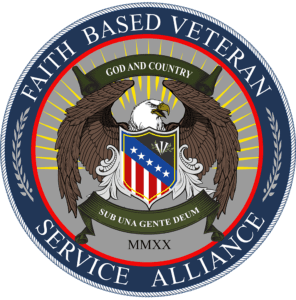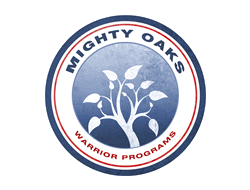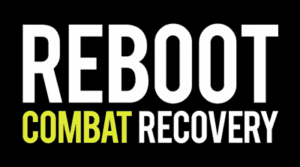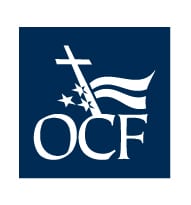Many military combat veterans, as well as civilian first responders, suffer from some sort of PTSD or depression. I’m no doctor, but I am a combat veteran, and I have a general antidote to PTSD and depression: Be a habitual giver; thus, have a purpose. My opinion is based on empirical evidence – which seems to agree with so-called experts. Here’s my take to empower veterans and first responders to deal with PTSD and related depression.
Context First
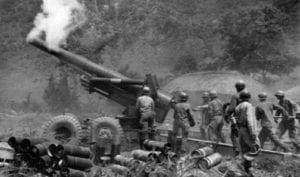 My Dad commanded an 8-inch howitzer battalion in WWII in support of the operation in Germany to seize the bridge at Remagen. My boyhood heroes were my father and Audie Murphy.
My Dad commanded an 8-inch howitzer battalion in WWII in support of the operation in Germany to seize the bridge at Remagen. My boyhood heroes were my father and Audie Murphy.
I retired from active duty in 1990, but I still have skin in the game. Three of my sons are US Army soldiers on active duty. All three were in special forces. Two still are; the third is now an Army aviator. All three served combat tours in the Middle East; one has served there five times. All of them told me that the reason they are in is because they were proud of me. They wanted to do something exciting and that made a difference.
My West Point class, 1966, and those just before and after, served in Vietnam as lieutenants and captains during the height of the war 1966-1970, and our classes suffered the most casualties. With my class and 1965, the Army decided we didn’t need to attend our branches’ basic courses.
A Harsh Reality
Following Airborne and Ranger Schools, for six months in a unit Stateside or Germany, we learned how to work with NCOs and soldiers. More than 100 in my class were in Vietnam as platoon leaders within one year after graduation. I was assigned as a rifle platoon leader in A Company, 2d Battalion, 503d Infantry, 173d Airborne Brigade – whose combat battalions were at Dak To in the Central Highlands where the mountainous terrain was covered with triple-canopy jungle infested with leeches, thick bamboo, and very aggressive mosquitoes.
I had been in Vietnam a week, waiting to go through the unit’s 5-day in-country orientation at base camp before deploying to Dak To. During my orientation, the company I was assigned to suffered heavy casualties by a larger NVA unit at Dak To (76 KIA, including all the platoon leaders; two were West Point classmates I had seen the week before).
This confirmed that we were playing hardball, and I knew that I had better focus on being the best platoon leader possible. I was lucky to have good NCOs who wanted to see me succeed, and I was smart enough to work with them.
Rain and More Rain
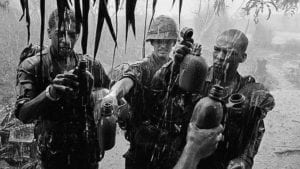 Arriving at Dak To, I saw the burned, scarred side of the mountainside where air strikes had tried in vain to help my company, survivors of which had since been withdrawn and were serving as perimeter defense for the fire support base. It was monsoon season, and by the time I reported to my company commander that night in his small hex tent to be briefed on his SOPs, I was soaking wet and muddy from setting up my hooch in the driving rain. As I left that meeting while rain pounded his tent, I went back out into the darkness and driving rain, I recall telling myself, “This is going to be a long (bleeping) year”.
Arriving at Dak To, I saw the burned, scarred side of the mountainside where air strikes had tried in vain to help my company, survivors of which had since been withdrawn and were serving as perimeter defense for the fire support base. It was monsoon season, and by the time I reported to my company commander that night in his small hex tent to be briefed on his SOPs, I was soaking wet and muddy from setting up my hooch in the driving rain. As I left that meeting while rain pounded his tent, I went back out into the darkness and driving rain, I recall telling myself, “This is going to be a long (bleeping) year”.
A week or so later, my newly reconstituted company was out on our “shakedown operation”. Jittery from the earlier catastrophe, the commander ordered us to form a perimeter on a ridgeline when the lead platoon encountered enemy. C Company was in another contact a kilometer or so away, and 105mm artillery was firing in its support. One of its six artillery pieces was “out of battery” and it sent two rounds by mistake right into A Company’s position.
Contact!
The first round came screeching toward my platoon and landed ten feet away, killing three of my men. Their squad leader and I heard it coming and we flopped to the ground safely just 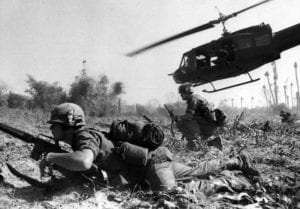 before it impacted. Seconds later the second round landed in the middle of the company perimeter killing and wounding several and severely wounding the company commander. In spite of this incident I later became a big fan of close-in artillery support, using it often.
before it impacted. Seconds later the second round landed in the middle of the company perimeter killing and wounding several and severely wounding the company commander. In spite of this incident I later became a big fan of close-in artillery support, using it often.
My first big contact occurred near Tuy Hoa while on a platoon patrol to clear heavily vegetated high ground overlooking another fire support base. During the fight one of my squad leaders right next to me was shot between the eyes and killed. I killed the shooter with a couple of hand grenades. After the fight, my soldiers told me that they approved of the way I had led the platoon; this was huge positive reinforcement.
“Battle of Dak To”
 My last big contact that tour was on November 12, 1967, during one of the early fights during the major, infamous “Battle of Dak To.” My platoon position was coming under attack, but I couldn’t determine whether my soldiers on a forward observation post (OP) had come back in. Since I didn’t want my men to fire until I knew the OP was in, I scampered toward them to bring them back. My radio operator (RTO), Art Fleming, then shouted that the OP was in and their radio had been shot out. He also told me that there were five NVA soldiers in a bomb crater just outside the perimeter.
My last big contact that tour was on November 12, 1967, during one of the early fights during the major, infamous “Battle of Dak To.” My platoon position was coming under attack, but I couldn’t determine whether my soldiers on a forward observation post (OP) had come back in. Since I didn’t want my men to fire until I knew the OP was in, I scampered toward them to bring them back. My radio operator (RTO), Art Fleming, then shouted that the OP was in and their radio had been shot out. He also told me that there were five NVA soldiers in a bomb crater just outside the perimeter.
The Crater
About that time, I could see these NVA raise their AK-47s above the edge of the crater and spray fire toward my platoon. My preferred solution was to have the squad leader closest to the crater handle the problem; however, the extreme and unprecedented din from all the gunfire and explosions did not permit any voice communication. So, I figured that this was going to be my “showtime” – the reason the Army paid me “the big bucks”.
The bomb crater, surrounded by scraggly bamboo, was about twenty feet from me. I would have preferred to lob grenades high angle over the bamboo; however, grazing incoming machine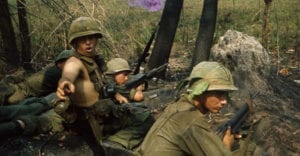 gun fire about a foot above the ground would have hit me. Throwing grenades low angle risked bouncing them off the bamboo. So, Plan B was to crawl out closer to the crater and flip grenades through the small gaps in the bamboo. I told two men to my left to cover me. I was about halfway to the crater, when a mortar round, certainly NVA, landed two feet to my left and splattered my left side with shrapnel (it also wounded the men to my left who were covering me).
gun fire about a foot above the ground would have hit me. Throwing grenades low angle risked bouncing them off the bamboo. So, Plan B was to crawl out closer to the crater and flip grenades through the small gaps in the bamboo. I told two men to my left to cover me. I was about halfway to the crater, when a mortar round, certainly NVA, landed two feet to my left and splattered my left side with shrapnel (it also wounded the men to my left who were covering me).
Close Call with EVAC
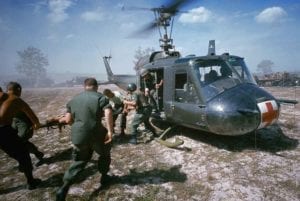
My RTO told the company commander that I was seriously injured and needed a medic. Somehow my platoon suppressed and drove off the NVA, and since my legs were OK, I was able, with help from the medic, to stumble back to cover behind a thick felled teak tree.
A major artery on the left side of my neck was severed. The medic saved me by clamping it, although later I learned that I had lost two quarts of blood. Plasma injected via IV tube prevented my going into shock. I also had a sucking chest wound, treated by placing a piece of plastic sheet over the wound to seal off air loss, and laying me on my left side to enable my right lung to function without also filling with blood. Heavy enemy fire prevented use of helicopters for an hour, until Air Force fighter-bombers arrived and plastered the enemy major positions.
Meanwhile, I stayed down behind the tree, as enemy bullets ground into it, and spoke with the company commander. My main concern was that we would be overrun and I would not be able to defend myself. Luckily that didn’t happen. When the first evacuation helicopter arrived, several litter cases went aboard behind the pilot; I was jammed into a tight space sitting next to the door gunner, and as we lifted off, he was shooting, and enemy green tracer rounds zipped past us. Quite a ride!
Doctor Kurris
At 71st Evac Hospital the last thing I did before undergoing surgery was to pop out my hard contact lenses and request their safe-keeping. The surgeon, Doctor Kurris, removed my spleen and 1/3 of my pancreas, tied off my severed left neck artery, and left me with an impressive array of surgical scars on my neck, lower and left chest, shoulder, forearm, and buttock. The back of my left hand is still partially numb. My condition then was “fair”, and my prognosis for recovery was “good”. Most importantly, I knew that I would survive and I was extremely lucky. I would stay in Vietnam until my fever disappeared; then two more weeks at 249th General Hospital at Camp Drake in Japan before going to Walter Reed Hospital to be sent on convalescent leave. I have tried unsuccessfully since then to find Dr. Kurris.
The Pentagon and Stereos
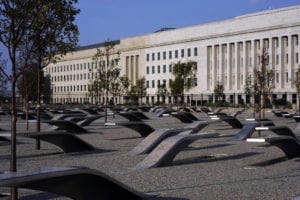 One funny story: A nurse at 71st asked me whether I wanted to notify my family. Not wanting to worry them, I replied that I would send a letter very soon. Well, my father was the number two personnel officer at the Pentagon. One of his assistants pointed out my name on the official casualty list, so my Dad placed a call to the hospital for me.
One funny story: A nurse at 71st asked me whether I wanted to notify my family. Not wanting to worry them, I replied that I would send a letter very soon. Well, my father was the number two personnel officer at the Pentagon. One of his assistants pointed out my name on the official casualty list, so my Dad placed a call to the hospital for me.
He asked me whether I’d like him to send anything. I replied that my checkbook had been destroyed, and I’d like more checks so I could buy some stereo gear in Japan. I guess he then figured that I wasn’t too badly off! BTW, I received the checkbook the day before leaving Japan, and I bought my audio gear.
Christmas 1967, with my family, was my best ever. I had survived and apparently would recover okay. But walking around shopping centers before Christmas, my mind was still on the battlefield. I couldn’t comprehend the stark contrast between the mall and the jungle, and I remember thinking what boring lives all these folks led.
This whole story represents what some would call “A Significant Emotional Event”! I felt empowered since I had looked death right in the eye and told it, “Not yet!”.
Resiliency
After a few months of reflection and recuperation as a general’s aide in Hawaii, I decided to return to Vietnam soonest. I knew I had performed well under fire, but I had a nagging question about whether I had lost my nerve. I didn’t think so, but I needed to see if I could still “ride the horse”; also, I had acquired a great set of combat skills and I wanted to continue to contribute and save lives. Thirteen months after being wounded I was back in Vietnam on my second tour.
During the flight back to Vietnam, where I knew exactly what I was in for, there were two popular songs of the time on the jet’s earphone sound system: 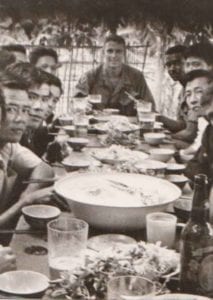 “The Last Waltz”, by Engelbert Humperdinck, and “Blame It on the Bossa Nova” by Eydie Gorme.
“The Last Waltz”, by Engelbert Humperdinck, and “Blame It on the Bossa Nova” by Eydie Gorme.
Ever since then whenever I hear those songs, which I still love, my mind is jerked back. My mind remembers that long, lonely flight back to Vietnam where I was again going to lay it all on the line. The real power of music is what it reminds you of! My jet was a bright yellow Braniff Airlines Boeing 727; it looked like a giant canary. I recall thinking that the VC/NVA would die laughing if they saw it.
Although I had orders to the 173d Airborne Brigade (since I had volunteered to return), needs of the Army caused me to be assigned instead to a 5-man Mobil Advisory Team (MAT) in the delta; this duty was not so exciting, but there I probably contributed more to our national objective of empowering the South Vietnamese to defend themselves.
The Pony Express
Since I had been diverted to the MAT program I had the option after six months to go to an American unit, which I did. I found a job as commander of a rifle company in 1st Cavalry Division: C Company, 2d Battalion, 7th Cavalry. I had just turned 25, and I was the “Old Man”. My radio call sign was “Pony Teams 6”. Best Job I have ever had.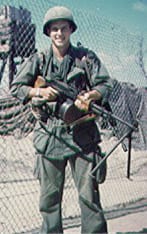
Initially, several good enemy contacts turned out very well with minimum casualties to friendlies – which led to several very positive developments. New replacement soldiers soon would tell me that the “word” in the battalion was that “If you wanted to survive and finish your tour, go to C Company”.
After I had been there a month, my battalion commander made it a part of the orientation for all new company commanders to spend three days with me in the field. My job was to explain to them my thought processes every step of the way. Now that is having your boss’s confidence! My successor, who came from 1st Cavalry Division G-2, told me that they had intercepts of NVA Radio traffic advising units to “Beware of Pony Teams”, a sure sign that we were doing our job well.
I saved my only R&R until my last week: Sydney, Australia was all I had dreamed of. What a great way to end my tour and unwind!
After my second tour and I reflected on all this, I felt like a king. I had accomplished exactly what I wanted. For me this was huge. I went on to have a very fulfilling Army career while marrying and raising five great kids, retiring from the Army in 1990. But nothing could match my time in Vietnam. Still can’t.
Making a Difference
With all of that as context, what pearls of wisdom should I leave with you? The one thing we all have to some degree is PTSD and occasional “blues” which may be a form of depression. It’s not a simple problem, but I believe that the universal antidote is to be a habitual giver, thus making a difference to others.
Section One
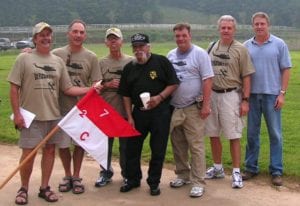
- For Pete’s sake, be proud you’re a veteran or first responder! You likely wouldn’t be reading this if you weren’t.
- Go to reunions! There you will give to each other as you talk about experiences – which is therapeutic. You never know whom you’ll see there who will change your life for the better.
- Forty years after Vietnam, during a reunion of my 1st Cav company, two former privates walked up to me independently with their wives and said to me: “Captain Brinker, I just wanted to tell you that you were the reason I finished my tour”. That’s priceless!
Section Two
- In April, 2016, preparing to attend a June reunion of the 173d Airborne Brigade, I received a call from my platoon RTO, Art Fleming. We spent eight hours 1-on-1 at the reunion; he told me in great detail what happened to me and the fate of the medic who saved me. Unfortunately, the medic was killed in action the next day. Art and I are now in regular contact.
- Maintain contact with other veterans: I was lucky to have attended the Infantry Officers Advanced Course at Fort Benning just after my second tour. Here, countless fellow officers with similar experiences mixed daily. I have always felt that our lengthy, frequent discussions in the snack bar between classes served as therapy for PTSD.
- As a veteran or first responder, you give. Look for ways to keep giving. Givers are the happiest people; it’s great for your own mental health because you find strength and purpose from helping others.
Section Three
- Share your knowledge: Teach at a school to make a difference: college, high school, middle school. I did substitute teaching during my first civilian job search. Once I sat in a high school math class with my oldest son who was worried that I would make a fool of myself and embarrass him. Instead, he told me later that I did a great job, and he was proud of me. Doing this also allowed me to learn more about, and develop relationships with, my kids’ friends.
- Share knowledge by writing a book: My favorite hobby, assisting, free-of-charge, drivers of broken down vehicles, led to my writing a book on the subject and teaching classes at the Continuing Education Department of my local community college. My sense of purpose comes from empowering others to prevent and contend with breakdowns.
- Help someone change a flat tire, or give them a jump start (see my website for pointers: http://roadsidesurvival.com/).
Section Four
- On Christmas morning, 2016, My wife and I went to my son’s house to watch grandchildren unwrap presents. There, reflecting back on such great times during my childhood with young, vibrant parents, I developed a case of blues, and I had to leave the room. Resolved to not ruin the day, after returning home I went out on nearby I-95 and made two rewarding roadside assists of strangers: Bye bye blues!
- Mow your neighbor’s lawn when he/she cannot.
- Make others’ day when they are down. Often, when I’m out and about and encounter someone not having a good day, I’ll get their attention politely and ask, “You gonna make it?”. Normally they respond with a puzzled look or ask, “What?”. I’ll then reply, “You know, you gonna make it?” Before they can respond, I’ll say, “We have no choice, do we?”. It always brings a laugh and smile.
Section Five
- Invest quality time in your kids and grandchildren! Most important of all: Set a good example for them.
- Be a foster parent or adopt a child. Lots of unfortunate kids out there need good parents.
- Donate blood; it saves lives.
Section Six
- Coach a youth athletic team.
- Pick up litter along roads in your neighborhood.
- Volunteer to feed homeless
Section Seven
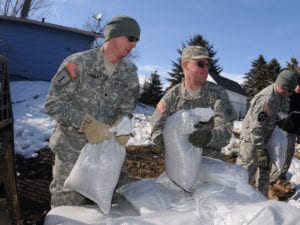
- Become member of volunteer Community Emergency Response Team (CERT).
- Visit loved ones and friends in the hospital. Maximize impact when they can appreciate it. During visits to my Dad in his final years I pushed his wheelchair past a bowl of decorative wooden Granny Smith apples. I would say, “You should grab one of them and take a bite.” He’d always reply, “No, they would break my teeth”. Once I put a real apple on the stack, and when we passed by, I suggested he take a bite, and I received his stock answer. When I took a huge bite from the real apple, he laughed so hard that he almost fell out of his wheelchair.
- Run for political office. Make a difference. (I know that I couldn’t do it, but some of you could)
Section Eight
- Write letters to the editor of your newspaper. You have earned that right, and your experiences provide priceless perspectives frequently missing in others who have not served.
- Long after you leave the military you’ll find that the bonds of love and respect are strongest with those with whom you have served in the military. My son Walter told me that he did not plan to re-enlist after his first hitch and a combat tour. I told him that before he did not re-enlist he should understand that thirty years later he would consider his military service the best years of his life, so he should take the biggest drink of military he could stand before leaving. He re-enlisted, and then secured a “Green-to-Gold” 4-year college scholarship from the Army so that he could get a commission and fly helicopters – which he does now at Fort Bragg.
- After you leave the military you’ll be glad that you experienced things others will only fantasize, see on TV and movies, and read about.
Section Nine
- While some play at video combat, you’ll likely decline since you realize the differences. These include no heat, sweat, rain, mosquitoes, leaches, fatigue, hunger, lack of privacy, getting shot and seeing others killed and wounded. “I call doing it for real, “Character Building 505”.
- You find that your priorities about life change. You don’t have to show off because you have already done things that most folks would never do on their own.
- Despite all the hardship of serving in the military, you will eventually look back on your military service as the best years of your life. Sometimes this realization takes a while. There is tremendous inner strength and satisfaction in being able to tell yourself: “Been there, Done that”.
Section Ten
- Researchers have discovered that exposure to near-death experiences actually strengthens us, since it requires self-reliance and overcoming adversity. Vietnam certainly strengthened me.
- Be a “Glass half full” person. Keep looking for the “Peaches and Poundcake”, even though you keep getting “Ham and Lima Beans”. Your time will come.
- PTSD is real. We all have some of it. Try to recognize it and overcome it by being a habitual giver. Seek therapy if you think you cannot cope alone or through associations and friendships.
- Substance abuse can be a problem. It’s a trip to nowhere. Seek professional help if you find yourself here.
You know, I kind of feel sorry for all those folks who are not veterans. With few exceptions, they have not experienced the camaraderie and life-changing things we have. I would do it all again. My bet, and hope, is that you would too!
God Bless You, and God Bless America!
Above is a special contribution of valuable insight and advice from Walt Brinker, Lieutenant Colonel (Retired), Infantry, US Army. For any further questions or inquiries on how this versatile information can apply to your life on a Spiritual level, feel free to contact us through the "I Have a Question," button below. Thank you.




